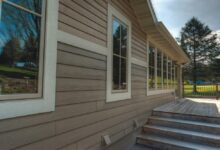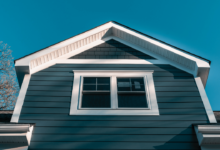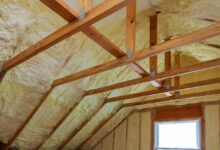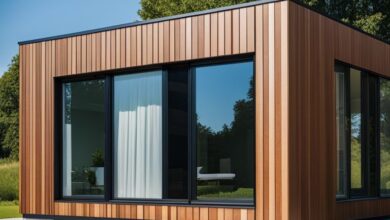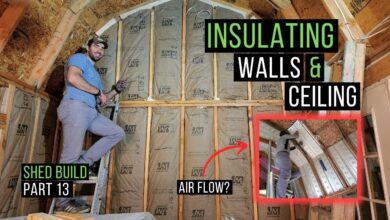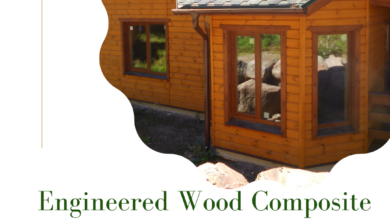Weather-resistant Insulated Siding A Comprehensive Guide
Imagine a home exterior that not only looks stunning but also significantly reduces energy bills and withstands the harshest weather conditions. This is the promise of weather-resistant insulated siding, a revolutionary advancement in home construction and renovation. This guide delves into the multifaceted world of this innovative material, exploring its composition, benefits, installation, environmental impact, aesthetic appeal, and cost-effectiveness.
From understanding the different types available to mastering proper installation techniques, we aim to equip you with the knowledge needed to make an informed decision about this transformative siding option.
We will explore the various materials used, comparing vinyl, fiber cement, and metal options, highlighting their unique properties and suitability for different climates and architectural styles. Furthermore, we will analyze the long-term cost savings associated with improved energy efficiency and reduced maintenance, ultimately demonstrating how weather-resistant insulated siding offers a compelling return on investment.
Defining Weather-Resistant Insulated Siding
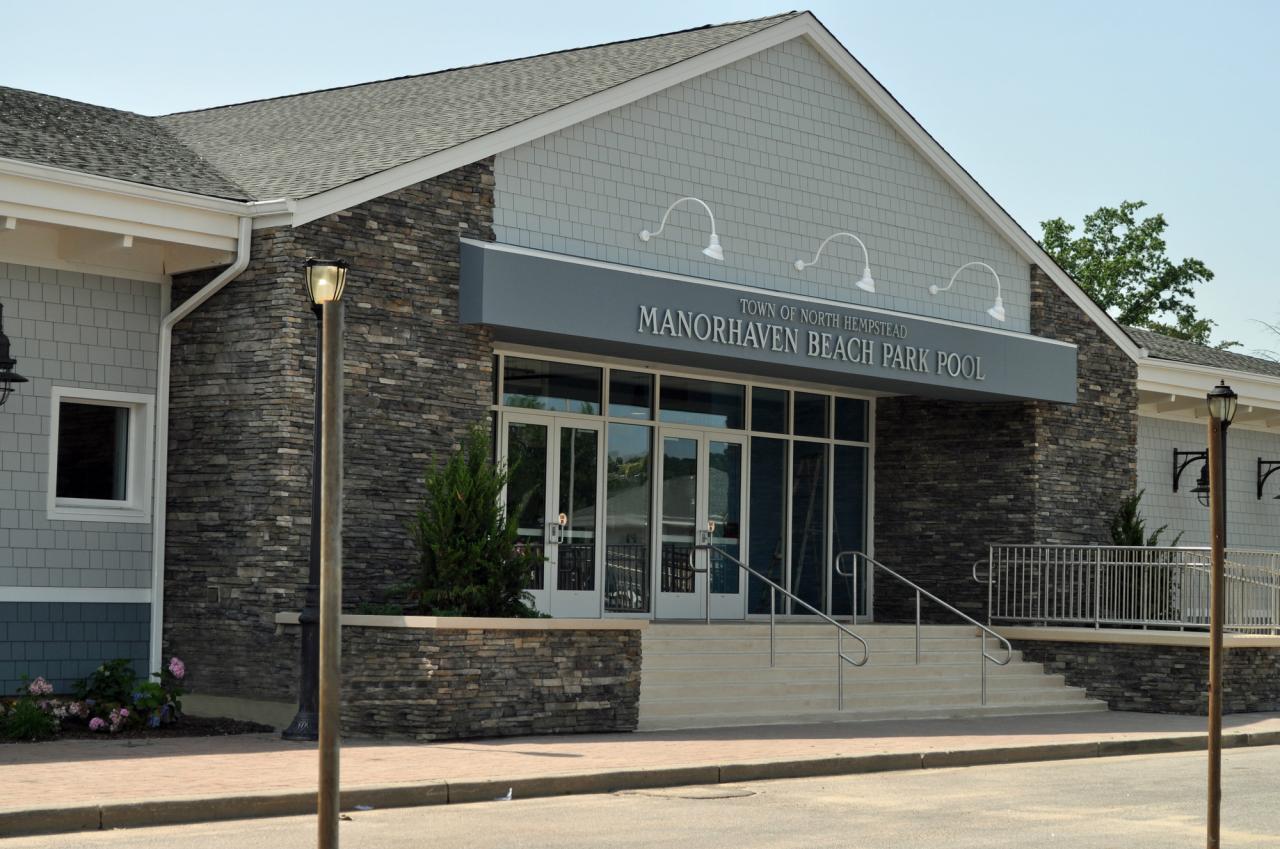
Weather-resistant insulated siding represents a significant advancement in exterior building materials, offering a combination of durability, energy efficiency, and aesthetic appeal. This type of siding is designed to withstand harsh weather conditions while providing superior insulation compared to traditional siding options. Its multi-layered construction contributes to its performance and longevity.Weather-resistant insulated siding typically consists of several key components.
An outer layer, often made of vinyl, fiber cement, or metal, provides protection from the elements such as rain, snow, wind, and UV radiation. This outer layer is usually designed to be low-maintenance and resistant to fading, chipping, and cracking. Beneath this protective shell lies an insulating core, commonly made of expanded polystyrene (EPS), extruded polystyrene (XPS), or polyurethane foam.
This core significantly improves the home’s thermal performance, reducing energy consumption for heating and cooling. Finally, a moisture barrier is often incorporated to prevent water intrusion and protect the insulation from damage. The specific materials and their thicknesses can vary depending on the manufacturer and the intended application.
Composition of Weather-Resistant Insulated Siding Materials
The materials used in weather-resistant insulated siding each contribute unique properties to the overall performance of the product. Vinyl siding is known for its affordability, low maintenance, and wide range of colors and styles. However, it may not be as durable as other options and can be susceptible to damage from impact. Fiber cement siding offers superior durability and fire resistance, mimicking the look of wood but requiring more maintenance.
Metal siding, often made of aluminum or steel, is extremely durable and long-lasting, offering excellent resistance to fire, insects, and rot. However, it can be more expensive than vinyl and may be prone to dents or scratches. The insulating core materials, such as EPS and XPS, provide varying levels of R-value (a measure of thermal resistance), influencing the overall energy efficiency of the siding.
Polyurethane foam, while offering excellent insulation, is less commonly used due to higher manufacturing costs.
Comparison of Different Types of Weather-Resistant Insulated Siding
A comparison of the three primary types – vinyl, fiber cement, and metal – reveals distinct advantages and disadvantages. Vinyl offers a balance of cost-effectiveness and ease of maintenance, making it a popular choice for many homeowners. Fiber cement provides exceptional durability and fire resistance, but at a higher initial cost and with increased maintenance requirements. Metal siding boasts superior longevity and weather resistance but is generally the most expensive option.
The choice of siding type depends heavily on budget, desired aesthetic, and the specific environmental conditions of the location.
Innovative Designs and Manufacturing Processes
Manufacturers are continually innovating in the design and manufacturing of weather-resistant insulated siding. One example is the development of siding with integrated features such as improved drainage systems to prevent water buildup and the incorporation of self-cleaning surfaces that reduce the need for frequent cleaning. Advanced manufacturing processes, such as high-pressure lamination, ensure a strong bond between the outer layer and the insulating core, maximizing the durability and performance of the product.
Some manufacturers are also exploring the use of recycled materials in the production of insulated siding, contributing to environmentally sustainable building practices. For instance, some vinyl siding now incorporates recycled PVC, while certain fiber cement options use recycled fly ash. These advancements aim to enhance both the performance and environmental profile of weather-resistant insulated siding.
Benefits and Applications

Weather-resistant insulated siding offers a compelling combination of aesthetic appeal and practical advantages, making it a superior choice for many building projects. Its inherent properties translate into significant long-term benefits for both homeowners and commercial property owners, impacting energy costs, maintenance requirements, and overall building lifespan.
The primary advantage lies in its enhanced energy efficiency. By incorporating a layer of insulation directly within the siding panel, heat transfer is significantly reduced compared to traditional siding materials. This means less energy is required to heat the building in winter and cool it in summer, leading to substantial savings on utility bills. The reduction in thermal bridging, a common issue with traditional siding where heat escapes through studs and other structural elements, further enhances its insulating capabilities.
Energy Efficiency Benefits
The energy efficiency gains from weather-resistant insulated siding are considerable. Studies have shown that these systems can improve a building’s insulation R-value by 20% or more compared to standard vinyl or wood siding. This translates directly into lower heating and cooling costs, potentially saving hundreds or even thousands of dollars annually depending on the building’s size, climate, and energy prices.
For instance, a homeowner in a region with harsh winters could see a substantial reduction in their natural gas consumption, while a homeowner in a hot climate might observe a considerable decrease in their electricity bills for air conditioning.
Performance in Diverse Climates
Weather-resistant insulated siding excels in various climates. In extremely cold regions, the integrated insulation helps maintain a comfortable indoor temperature while minimizing heat loss. Conversely, in hot and humid climates, the siding’s insulating properties help keep the interior cool, reducing the strain on air conditioning systems and lowering energy consumption. Its resistance to moisture penetration also helps prevent the growth of mold and mildew, a common problem in humid environments.
For example, in coastal areas prone to high humidity and salt spray, this siding offers superior protection compared to traditional wood siding, which is susceptible to rot and decay.
Residential and Commercial Applications
The versatility of weather-resistant insulated siding makes it suitable for a wide range of applications. In residential construction, it’s an ideal choice for new builds and renovations alike. Its ease of installation and attractive appearance make it a popular option for both single-family homes and multi-family dwellings. In commercial settings, this siding is frequently used on office buildings, retail spaces, and industrial structures where durability and energy efficiency are crucial.
The ability to customize the siding’s appearance with various colors and textures further enhances its suitability for different architectural styles.
Cost-Effectiveness Comparison
While the initial cost of weather-resistant insulated siding might be higher than that of traditional siding, the long-term cost savings from reduced energy consumption often outweigh the initial investment. The following table provides a comparison of costs and lifespan for different siding options:
| Siding Type | Initial Cost (per sq ft) | Estimated Lifespan (years) | Long-Term Cost (per sq ft over lifespan) |
|---|---|---|---|
| Weather-Resistant Insulated Siding | $8-15 | 50+ | $0.16-$0.30 per year |
| Vinyl Siding | $4-8 | 20-30 | $0.13-$0.40 per year |
| Wood Siding | $6-12 | 15-25 | $0.24-$0.80 per year |
| Fiber Cement Siding | $10-18 | 50+ | $0.20-$0.36 per year |
Note: These cost estimates are approximate and can vary based on factors such as labor costs, material quality, and regional pricing. The long-term cost is calculated by dividing the initial cost by the estimated lifespan.
Installation and Maintenance
Proper installation and regular maintenance are crucial for maximizing the lifespan and performance of weather-resistant insulated siding. Following best practices ensures a beautiful and long-lasting exterior for your home. This section details the installation process, maintenance tips, and common problem-solving strategies.
Step-by-Step Installation Guide
Installing weather-resistant insulated siding involves several key steps. Careful preparation and attention to detail are essential for a successful installation. Improper installation can lead to issues such as water damage, energy inefficiency, and an aesthetically unpleasing finish.
- Preparation: Begin by thoroughly cleaning the existing wall surface, removing any loose paint, debris, or damaged siding. Ensure the wall is structurally sound and level. This step is vital to provide a solid base for the new siding.
- Framing and Sheathing (if necessary): If installing over existing siding, assess its condition. Damaged or deteriorated sheathing should be replaced. New framing may be required for certain applications to ensure proper support and alignment for the new siding.
- Water-Resistive Barrier: Install a water-resistive barrier (WRB) over the sheathing. This layer protects the underlying structure from moisture intrusion. Overlapping seams and proper sealing are crucial for effectiveness.
- Fastening: Secure the insulated siding panels to the wall using appropriate fasteners. Follow the manufacturer’s recommendations for fastener type, spacing, and penetration depth. This ensures proper attachment and prevents damage to the siding.
- Panel Installation: Start at a corner or designated starting point and work your way across the wall. Ensure proper alignment and overlap between panels, following the manufacturer’s guidelines for installation patterns. This ensures a neat and uniform appearance.
- Finishing: Install trim, corners, and other finishing pieces as needed. Seal any gaps or openings to prevent water infiltration. Careful attention to detail at this stage completes the installation process.
- Inspection: A final inspection is critical to identify any issues, such as gaps or misaligned panels, before sealing. Addressing these issues promptly prevents future problems.
Maintenance and Cleaning Best Practices
Regular maintenance extends the lifespan of weather-resistant insulated siding. Cleaning and occasional inspections are vital. Neglecting maintenance can lead to premature deterioration and costly repairs.
Cleaning should be performed at least once or twice a year, depending on environmental factors. A gentle solution of mild detergent and water, applied with a soft brush or sponge, is usually sufficient. For stubborn stains, consider using a pressure washer set to a low pressure to avoid damaging the siding. Always rinse thoroughly with clean water afterwards.
Inspect the siding regularly for any signs of damage, such as cracks, loose panels, or water damage. Addressing minor issues promptly prevents them from escalating into more significant problems.
Common Installation Problems and Solutions
Several issues can arise during installation. Understanding these problems and their solutions helps ensure a smooth process.
| Problem | Solution |
|---|---|
| Uneven wall surface | Use shims or furring strips to level the surface before installing the siding. |
| Improper fastener placement | Follow manufacturer’s recommendations for fastener type, spacing, and penetration depth. |
| Gaps between panels | Ensure proper alignment and overlap between panels. Use appropriate caulking or sealant to fill gaps. |
| Water damage | Ensure proper installation of the water-resistive barrier and seal all gaps and openings. |
Tools and Materials Needed for Installation
Having the right tools and materials readily available streamlines the installation process. A comprehensive list ensures a smooth and efficient installation.
- Measuring tape
- Level
- Circular saw or hand saw
- Drill with appropriate drill bits
- Safety glasses and gloves
- Weather-resistant insulated siding panels
- Fasteners
- Water-resistive barrier
- Caulk or sealant
- Trim and finishing pieces
Environmental Impact and Sustainability
The environmental impact of weather-resistant insulated siding is a complex issue encompassing its manufacturing, lifespan, and eventual disposal. Understanding this impact is crucial for making informed choices that minimize the overall environmental footprint of building projects. This section explores the environmental considerations associated with this popular building material, examining both potential drawbacks and opportunities for sustainable practices.The manufacturing process of weather-resistant insulated siding involves the extraction and processing of raw materials, energy consumption during production, and the generation of waste.
Different materials have varying environmental impacts. For instance, vinyl siding, a common choice, is derived from petroleum, a non-renewable resource, and its production releases greenhouse gases. Fiber cement siding, while more durable, requires significant energy input during manufacturing and often involves the use of cement, a material with a high carbon footprint. Wood siding, a more natural option, relies on sustainable forestry practices to minimize its environmental impact, but transportation and processing still contribute to its overall footprint.
Manufacturing Processes and Greenhouse Gas Emissions
The manufacturing processes of various weather-resistant insulated siding materials differ significantly, leading to varying levels of greenhouse gas emissions. Vinyl siding production is energy-intensive and relies heavily on fossil fuels, resulting in substantial carbon dioxide emissions. Fiber cement siding production, while potentially using less fossil fuel, generates significant dust and waste during the manufacturing process. Conversely, wood siding, sourced from sustainably managed forests, has a lower carbon footprint during production, but transportation and processing still contribute to its environmental impact.
A life cycle assessment (LCA) comparing different materials can provide a quantitative comparison of their respective greenhouse gas emissions across their entire lifespan. For example, a study comparing vinyl, fiber cement, and wood siding might reveal that wood siding from sustainably managed forests has the lowest overall carbon footprint, followed by fiber cement, with vinyl siding having the highest.
Sustainable and Eco-Friendly Siding Options
Several sustainable and eco-friendly options exist within the weather-resistant insulated siding category. Recycled materials are increasingly incorporated into siding production. For example, some manufacturers use recycled plastic in vinyl siding formulations, reducing the reliance on virgin petroleum. The use of rapidly renewable materials, such as bamboo, in composite siding offers a sustainable alternative. Furthermore, the development of siding with improved insulation properties can contribute to energy efficiency in buildings, reducing the overall environmental impact over the building’s lifetime.
Finally, siding made from reclaimed wood offers a highly sustainable option, diverting waste from landfills and reducing the demand for newly harvested timber.
Minimizing Environmental Impact Through Installation and Maintenance
Proper installation and maintenance practices play a crucial role in minimizing the environmental impact of weather-resistant insulated siding. Careful installation minimizes waste during the construction process, while regular maintenance extends the lifespan of the siding, delaying the need for replacement and reducing the environmental burden associated with disposal. Proper disposal of old siding is also crucial. Many municipalities offer recycling programs for certain types of siding, diverting waste from landfills.
For example, some regions have programs to recycle vinyl siding, which can be processed and used in the production of new products. In contrast, disposing of fiber cement siding often requires special handling due to the presence of asbestos in some older products.
Visual Appeal and Design Considerations

Weather-resistant insulated siding offers a remarkable opportunity to enhance a home’s aesthetic appeal while providing superior protection. The diverse range of colors, textures, and styles available allows homeowners to seamlessly integrate their siding choice with their architectural style and personal preferences, significantly impacting curb appeal and property value.The visual impact of weather-resistant insulated siding extends beyond mere functionality; it’s a key element in creating a visually pleasing and cohesive exterior design.
Careful consideration of color palettes, texture choices, and their relationship to the overall architectural style can transform a home’s appearance, making it stand out or blend harmoniously with its surroundings.
Color Options and Textures
Weather-resistant insulated siding is available in a vast array of colors, allowing homeowners to express their individual style. Popular choices include classic neutrals like white, beige, and gray, which offer timeless elegance and versatility. For a bolder statement, vibrant hues such as deep blues, earthy greens, and warm reds can create a striking focal point. Beyond solid colors, many manufacturers offer wood-grain finishes, stone patterns, and even stucco-like textures, adding depth and visual interest.
These textures can mimic the look of natural materials without the associated maintenance challenges.
Siding Choices and Architectural Styles
The interplay between siding color and texture and architectural style is crucial for creating a visually harmonious exterior. For example, a traditional Victorian home might benefit from siding with a deep, rich color and intricate wood-grain texture, evoking a sense of history and craftsmanship. Conversely, a modern minimalist home might be best complemented by sleek, clean lines and a neutral color palette, emphasizing simplicity and sophistication.
A ranch-style home could be enhanced with a lighter color and a horizontal plank pattern to accentuate its low-profile design. Using contrasting colors on trim and accents can further emphasize architectural details and add visual depth.
Curb Appeal Enhancement
Weather-resistant insulated siding plays a significant role in enhancing a home’s curb appeal. A well-chosen siding can instantly modernize an outdated home, increase its market value, and create a welcoming atmosphere. The durability and low-maintenance nature of the siding ensure that the enhanced appearance is long-lasting, requiring minimal upkeep. By protecting the underlying structure from the elements, the siding also contributes to the overall health and longevity of the home, further enhancing its value and curb appeal.
Visual Representation of Aesthetic Impact
Imagine a modest Cape Cod style home. First, envision it clad in a light beige vinyl siding with a subtle wood-grain texture. This creates a classic, understated look that complements the home’s traditional charm. Now, imagine the same home with deep charcoal gray siding featuring a smooth, contemporary finish. This transforms the home’s appearance, giving it a more modern and sophisticated feel.
Finally, picture the house with warm, earthy brown siding mimicking the look of cedar shingles, adding rustic appeal and a touch of natural warmth. These three examples demonstrate how different siding choices can dramatically alter the overall aesthetic of a home, impacting its perceived age, style, and overall curb appeal. The subtle texture variations, coupled with the stark color differences, highlight how easily the siding can alter the house’s visual character.
Cost Analysis and Return on Investment
Choosing new siding is a significant investment, and understanding the costs and potential returns is crucial. Weather-resistant insulated siding, while having a higher upfront cost than some alternatives, often offers substantial long-term savings through improved energy efficiency and reduced maintenance. This section will analyze the cost factors and demonstrate how to calculate the return on investment (ROI) for this type of siding.The initial cost of weather-resistant insulated siding typically exceeds that of traditional vinyl or fiber cement siding.
However, this higher initial investment is often offset by significant long-term savings. Energy efficiency improvements resulting from the insulation layer translate directly into lower heating and cooling bills. Furthermore, the durable nature of this siding reduces the need for frequent repairs and replacements, further contributing to long-term cost savings.
Comparison of Initial Costs
Weather-resistant insulated siding’s initial cost is higher than vinyl or fiber cement. For example, a 1,500 square foot house might see a cost difference of $5,000 to $10,000 or more between insulated siding and vinyl, depending on the specific product and labor costs in your region. Fiber cement sits somewhere in between, often costing more than vinyl but less than insulated siding.
This price difference is primarily due to the added insulation layer and the often more robust construction of the panels themselves. The higher cost reflects the improved performance and longevity of the product.
Long-Term Cost Savings from Energy Efficiency
The insulation layer in weather-resistant insulated siding significantly reduces heat transfer, leading to lower energy consumption. This translates directly into lower utility bills. The extent of these savings depends on factors such as climate, home size, and existing insulation levels. However, studies have shown that energy savings can range from 15% to 30% annually, depending on the specific product and installation.
For a household spending $2,000 annually on heating and cooling, a 20% reduction would represent a saving of $400 per year.
Return on Investment (ROI) Calculation
Calculating the ROI for weather-resistant insulated siding involves comparing the initial investment with the cumulative long-term savings. A simplified formula is:
ROI = (Total Savings – Initial Investment) / Initial Investment – 100%
To illustrate, consider a $15,000 investment in insulated siding that yields $400 in annual energy savings. Over 10 years, the total savings would be $4,
000. Using the formula
ROI = ($4,000 – $15,000) / $15,000 – 100% = -73.33%
This negative ROI highlights the importance of considering the longer-term perspective. The longer the siding remains in place (often 30-50 years), the more likely the ROI will become positive. Furthermore, reduced maintenance costs should also be factored into the calculation.
Cost Breakdown and Potential Long-Term Savings
| Cost Category | Estimated Cost (Example) | Annual Savings (Example) | Savings Over 10 Years (Example) |
|---|---|---|---|
| Materials | $10,000 | – | – |
| Labor | $5,000 | – | – |
| Total Initial Cost | $15,000 | – | – |
| Energy Savings (Annual) | – | $400 | $4,000 |
| Reduced Maintenance (Annual) | – | $100 | $1,000 |
| Total Annual Savings | – | $500 | $5,000 |
Note
These are example figures and will vary greatly depending on factors like location, home size, and chosen materials. Consult with contractors for accurate estimates.
Last Point
Weather-resistant insulated siding represents a significant leap forward in home exterior solutions, offering a compelling blend of energy efficiency, durability, aesthetic appeal, and long-term cost savings. By understanding the diverse options available, the installation process, and the associated environmental considerations, homeowners and builders can confidently select the ideal siding to enhance their property’s value and protect it from the elements for years to come.
The potential for significant energy savings, reduced maintenance, and increased curb appeal makes weather-resistant insulated siding a truly worthwhile investment for enhancing both comfort and property value.
Question Bank
What is the lifespan of weather-resistant insulated siding?
The lifespan varies depending on the material and proper maintenance, but generally ranges from 30 to 50 years.
Can I install weather-resistant insulated siding myself?
While possible for some DIY enthusiasts with experience, professional installation is often recommended for optimal results and warranty coverage.
Does weather-resistant insulated siding require special cleaning products?
Generally, mild soap and water are sufficient. Avoid abrasive cleaners that could scratch the surface.
How does weather-resistant insulated siding impact home insurance premiums?
Some insurance companies offer discounts for homes with energy-efficient features, including this type of siding. Check with your provider.
Is weather-resistant insulated siding recyclable?
Recyclability varies depending on the material. Check with your local waste management facilities for specific guidelines.


